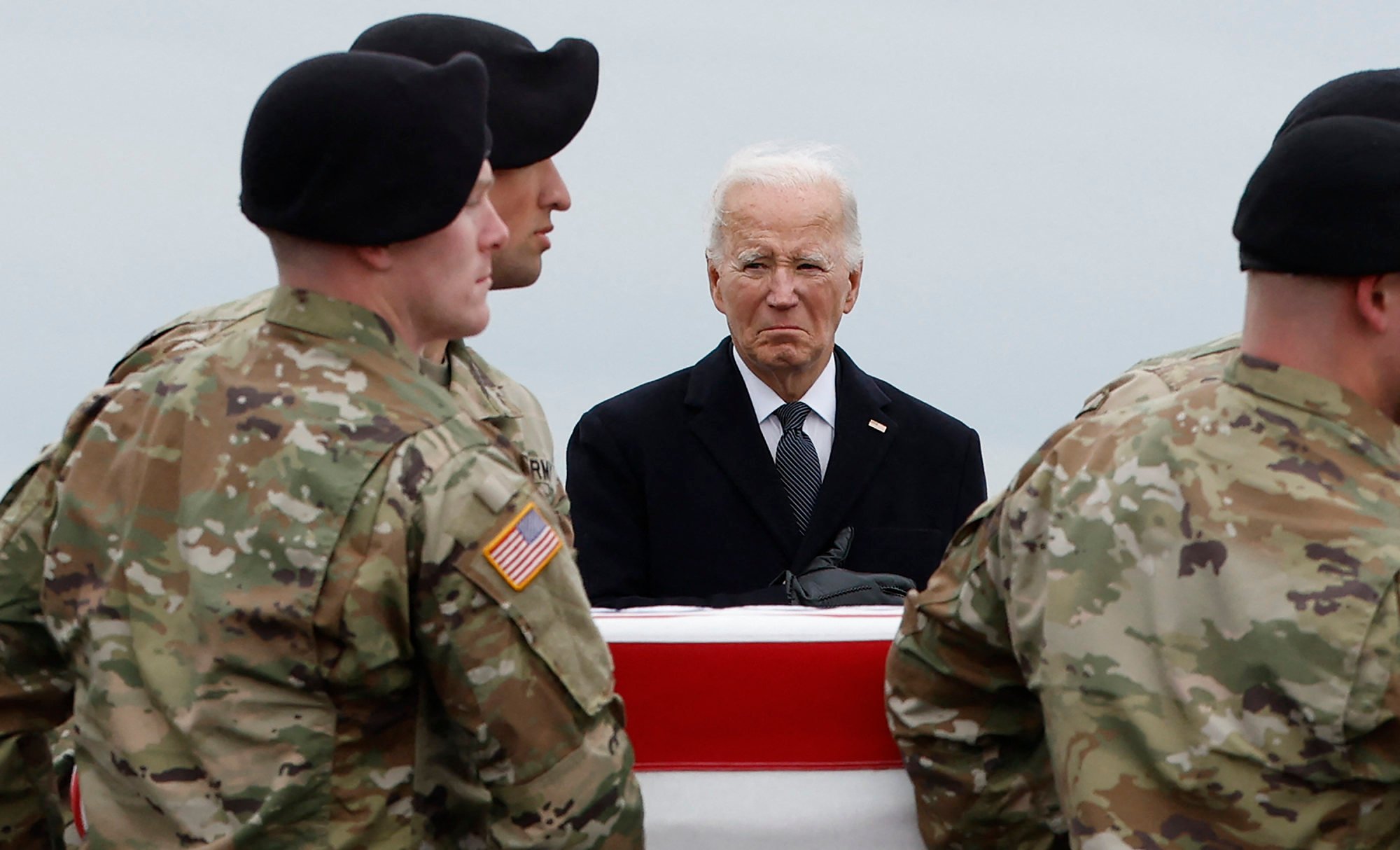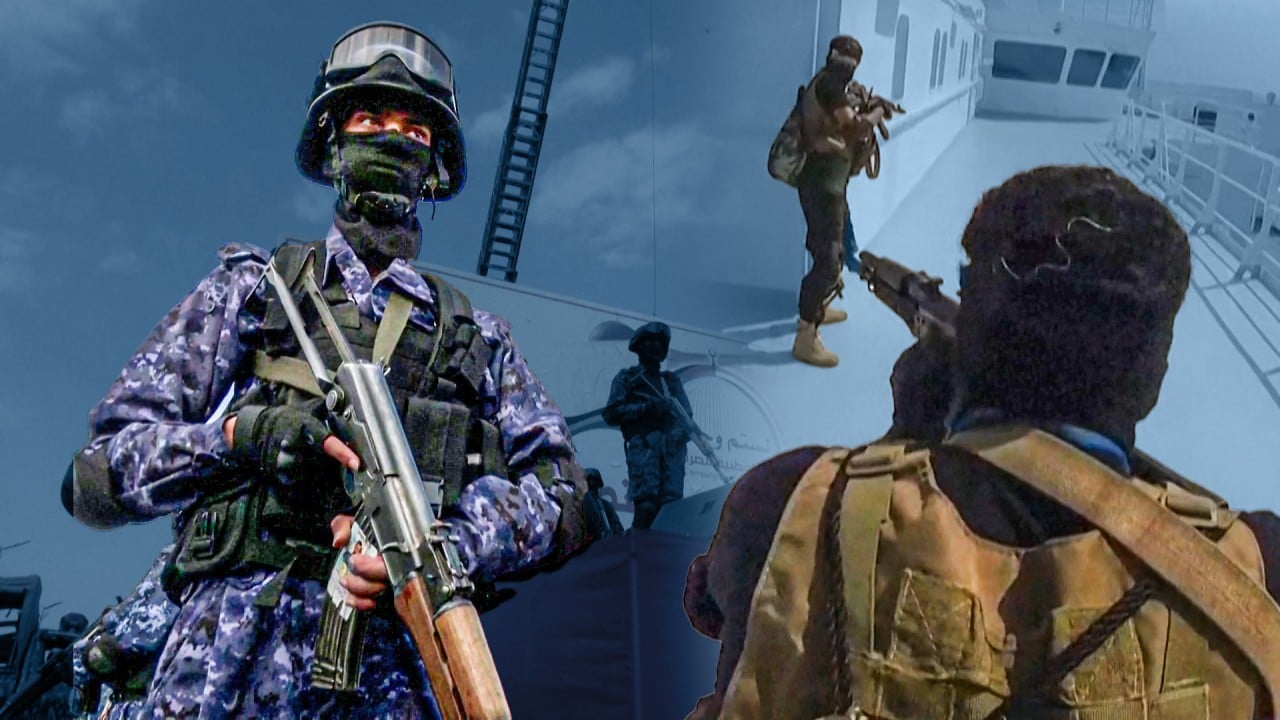
US hits Iran-linked targets in Iraq and Syria in retaliation for deadly drone attack in Jordan
- The US military says strikes hit over 85 targets, including command and control centres, with Syria saying the US is fuelling the conflict in a ‘very dangerous way’
- Iraq warns of potential ‘disastrous’ consequences, with the fatal strikes coming shortly after a US airbase military ritual for three soldiers killed in a drone attack in Jordan
Dozens of people, including Iranian-backed militia fighters, were killed in US overnight airstrikes in Iraq and neighbouring Syria, a war monitor and government sources said on Saturday.
Washington launched retaliatory air strikes against Iranian forces and Tehran-backed militia groups on Friday, following a deadly drone attack on an American base in Jordan on January 28 that killed three soldiers.
The United States blamed the Sunday drone attack on Iran-backed forces, but did not strike the country’s territory, with Washington seeking to deter future attacks while stopping short of all-out war with Tehran – something both sides have sought to avoid.
“Our response began today. It will continue at times and places of our choosing,” President Joe Biden said in a statement on Friday.
“The United States does not seek conflict in the Middle East or anywhere else in the world. But let all those who might seek to do us harm know this: If you harm an American, we will respond,” he added.

On Saturday Syria’s foreign ministry condemned the US attack, saying Washington was fuelling conflict in the region in a “very dangerous way”.
The US strikes killed “a number of civilians and soldiers, wounded others and caused significant damage to public and private property”, the Syrian military said in a statement.
“The occupation of parts of Syrian territory by US forces cannot continue,” it added, affirming the army’s “determination to liberate all Syrian territory from terrorism and occupation”.
Iraq warned of potential “disastrous” consequences for national and regional security and stability from the US strikes, and European foreign ministers meeting in Brussels urged all parties to avoid further escalation.
The US military action was a “violation of Iraq’s sovereignty,” General Yehia Rasool, a spokesperson for Iraq’s prime minister, said in a statement.
What are US troops doing in the Middle East and where are they?
His government said “blatant aggression” had killed 16 people including civilians, and injured 25. Iraq said it will summon the US chargé d’affaires in Baghdad to hand him an official protest note over the strikes.
The strikes left at least 23 members of the Iranian-backed militias dead in Syria, according to a war monitor.
A cautious calm was on Saturday prevailing in eastern Syria near the border with Iraq, the Syrian Observatory for Human Rights added.
Josep Borrell, the EU’s top foreign affairs official, said on Saturday that the Middle East is like “a boiler that can explode”.
“We call on everybody to try to avoid an escalation,” Borrell said before the start of the Brussels meeting. His comments were echoed by other officials. “Our common goal has to be to prevent a spillover,” said Austrian Foreign Minister Alexander Schallenberg. “This is a powder keg.”
The US strikes targeted the Islamic Revolutionary Guard Corps Quds Force as well as “affiliated militia groups,” with American forces including long-range bombers flown from the United States hitting “more than 85 targets,” the US Central Command (Centcom) said in a statement.

“The air strikes employed more than 125 precision munitions,” Centcom said. Targets included command and control and intelligence centres as well as rocket, missile and drone storage facilities belonging to militia groups and Iranian forces “who facilitated attacks against US and coalition forces.”
US National Security Council spokesman John Kirby told journalists the strikes lasted about 30 minutes, though they involved a lengthy trip for the B-1 bombers that flew from the United States.
He said the Defence Department was still assessing damage from the strikes – which hit targets at seven separate facilities – but that the United States believed the raids were successful, and made clear that more would follow.
The United States blamed Sunday’s drone attack in Jordan on Iran-backed groups, but did not strike inside Iranian territory, with both Washington and Tehran seemingly keen to avoid all-out war.
The United States has some 900 troops in Syria and 2,500 in neighbouring Iraq as part of an international coalition against Islamic State group, a jihadist organisation that once controlled swathes of both countries.
Syrian Observatory for Human Rights chief Rami Abdel Rahman said that at least 26 major sites housing pro-Iranian groups were destroyed in Syria, including weapons depots.
A weapons warehouse and a command centre belonging to pro-Iranian groups were also targeted in western Iraq, along the Syrian border, two Iraq security sources said, resulting in at least “some injuries.”
The strikes represent a “significant escalation,” according to Allison McManus, managing director for national security and international policy at the Centre for American Progress.
But she was sceptical about the impact, adding: “We have not seen that similar tit-for-tat strikes have had a deterrent effect.”
Iraq, whose prime minister called for the departure of international troops after a previous US strike in Baghdad, condemned the latest military action as a violation of its sovereignty.
Kirby said Washington “did inform the Iraqi government prior to the strikes,” but did not elaborate on Baghdad’s response.
Biden earlier Friday attended a solemn military ritual at a Delaware airbase for the return of the three soldiers killed in Sunday’s drone attack in Jordan.
Pentagon chief Lloyd Austin and the chairman of the Joint Chiefs of Staff, General CQ Brown, also attended what is known as a “dignified transfer” – their presence highlighting the relative rarity of returning dead US service members in the wake of the exit from Afghanistan in 2021.
The soldiers killed on January 28 were the first US military deaths from hostile fire in the Middle East since the October 7 Hamas surprise attack on Israel.
That attack sparked a devastating Israeli assault on Gaza, which has stoked tensions and violence in the region and dragged it ever closer to an all-out conflict.
US and coalition troops have been attacked more than 165 times in Iraq, Syria and Jordan since mid-October with weapons including drones, rockets and short-range ballistic missiles.
Dozens of American personnel were wounded in previous attacks, many of which have been claimed by a loose alliance of Iran-linked armed groups that opposes US support for Israel in the Gaza conflict and wants American troops out of the region.
Republican Speaker of the House Mike Johnson hit out at Biden’s operation as too little, too late.
“Unfortunately, the administration waited for a week and telegraphed to the world, including to Iran, the nature of our response,” he said in a statement on Friday.
“The public hand-wringing and excessive signalling undercuts our ability to put a decisive end to the barrage of attacks endured over the past few months.”
Yemen’s Iran-backed Houthi rebels, meanwhile, began targeting international shipping in November, sparking US and British air strikes aimed at reducing their ability to hit commercial vessels.
Additional reporting by Reuters, Bloomberg, dpa

.png?itok=arIb17P0)
